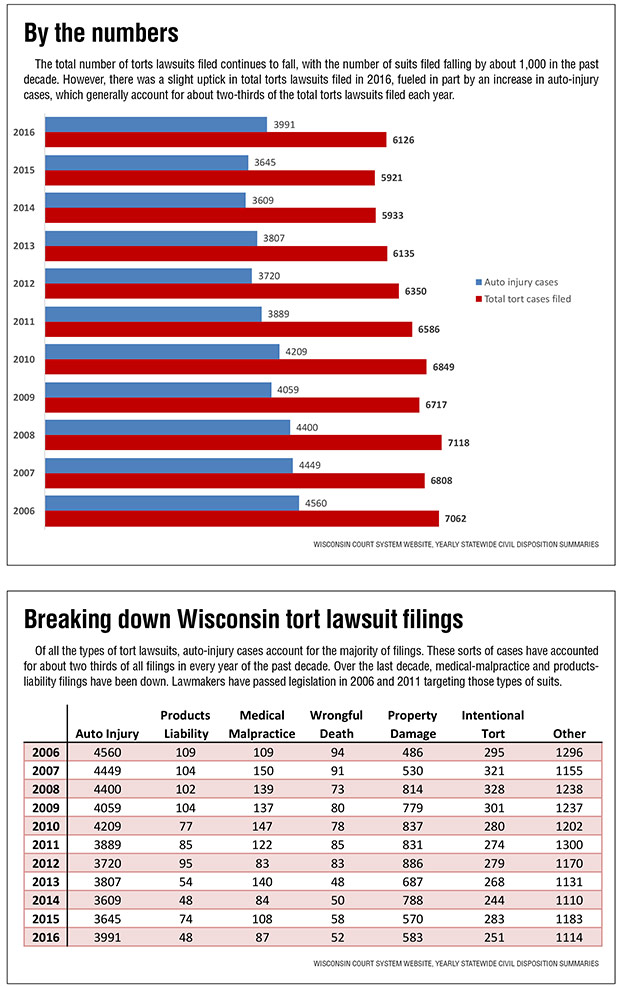Despite latest uptick, state tort lawsuits continue downward trend
By: Erika Strebel, [email protected]//August 9, 2017//
Despite latest uptick, state tort lawsuits continue downward trend
By: Erika Strebel, [email protected]//August 9, 2017//

For decades, plaintiffs throughout the U.S. have been filing fewer tort lawsuits. According to recent news reports, about 10 out of every 1,000 Americans filed tort lawsuits in 1993. By 2015, the number was down to less than 2 in 1,000 Americans.
Wisconsin is no different. Tort lawsuit filings here have been steadily decreasing for more than 30 years. The trend is not unrelenting, though. For the first time in six years, there was an increase in tort filings in 2016; plaintiffs filed about 200 more cases that year than they had in 2015.
Stephen Daniels, research professor at the American Bar Foundation, said he and his fellow researchers, in a recent study of Texas torts filings, noticed a similar increase in auto cases in the last few years.
“The really interesting question is: Why the uptick?” he said. “God knows Wisconsin and Texas and Wisconsin are not the same.”
When Daniels asked plaintiffs’ lawyers to weigh in on the increase, there was no agreement on the exact cause. Some pointed to the strong economy, which in Texas has given rise to a higher number of accidents as trucks increasingly travel the state’s roads.
In Wisconsin, various defense and plaintiffs attorneys agree that last year’s increase – however slight – was most likely the result of the country’s economic strength. Plaintiffs attorneys also note that they’ve become increasingly likely to find themselves in fights with insurance companies over payouts offered to their clients in cases stemming from car wrecks.
Vehicle-injury lawsuits usually make up about two-thirds of all torts lawsuits filed in the state in any given year. And some of the biggest increases of the past two years have been of these types of suits. Forty more vehicle-accident lawsuits were filed in 2015 than in 2014, and 200 more in 2016 than 2015.
Daniels said it may be too early to tell, but the uptick in auto injury cases could be a sign that Americans are becoming reluctant to file lawsuits.
“For auto cases, we thought a lot of that didn’t come from tort reform from the state Legislature or what the state supreme court did but in large part … from the ongoing public relations campaign demonizing tort and plaintiffs lawyers,” he said. “People were just not bringing suits.”
Travis Rhoades, a defense attorney at Crivello Carlson who is on the board of the Wisconsin Defense Counsel, the state’s civil defense bar, said one cause of these increases is fairly obvious: People tend to drive more when the economy is strong.
“And the more people on the road, the higher the number of accidents are going to be,” Rhoades said.
Mark Thomsen, a personal-injury lawyer at Gingras, Cates & Wachs, agreed, noting that low gas prices have also helped make driving more popular in recent years. He and his colleague Benjamin Wagner, a personal injury lawyer with Habush Habush & Rottier in Milwaukee, pointed to yet another possible explanation.
“I have more cases in suit that I would typically have,” Thomsen said. “They are auto cases where the insurance company is not making fair presuit offers.”
Thomsen and Wagner say they suspect the low-ball offers are coming from insurers who have outsourced their adjusters in order to keep costs down.
However, Paul Curtis, a defense lawyer at Madison-based Axley Brynelson, said his experience working on auto-injury cases has been different. Curtis said there is little to no evidence that his clients and others have been making unfair offers or hiring adjusters from out of state.
“I don’t agree,” Curtis said. “When I get my files in, I get the insurance company adjuster’s notes in them. Quite frankly, they’ve been offered a fair amount of money.”
Whatever the cause, the increase seen in 2016 comes as an anomaly amid decades in which tort filings have become less and less common.
In 1982, more than 10,000 tort lawsuits were filed in state circuit courts. That meant that the 6,000 cases filed in 2016, even though marking an increase from the previous year, still came as a steep drop-off from historical figures. The past decade alone has seen the number of annual filings decrease by about 1,000, according to statistics from the Wisconsin court system’s yearly reports.
Some take both these numbers and the comparable national figures as signs that Americans perceive the civil-justice system as being inaccessible or unfair.
Wagner says part of his mission as president of the Wisconsin Association of Justice, the plaintiffs’ bar association, is to fight that perception by encouraging his colleagues to exercise their Seventh Amendment right to pursue a jury trial in civil cases.
“I firmly believe in the jury system,” Wagner said. “And the same potential jurors who may feel like the system is stacked against them are the same ones who might find themselves on a jury.”
Attorneys from both sides note that the steady decrease in filings can in part be traced back to legislation. In 2011, for instance, the state Legislature overhauled the state’s product-liability laws by increasing the burden of proof in design-defect cases and bringing back the open-and-obvious-danger defense.
Lawmakers also took steps to curb medical-malpractice lawsuits. Starting in 1995, the legislature capped the noneconomic damages that could be awarded in medical cases by setting a maximum level that changed every year based on the cost of living. A little more than a decade later, lawmakers placed a flat $750,000 cap on noneconomic damages.
State courts saw fewer than 100 of either type of lawsuit filed in 2016.
Rhoades and Wagner said torts lawsuits might be falling in number both because the cost of bringing suits has risen in recent years and vehicles have generally become safer.
For Rhoades, who specializes in product-liability and property-damage claims, said plaintiffs could also simply have become more cautious about filing lawsuits in the first place.
“I think what it means, at least in my practice, is that plaintiffs are evaluating claims more carefully in the presuit stages and (there is) more involvement of defendants in presuit claims,” he said.

Legal News
- Former law enforcement praise state’s response brief in Steven Avery case
- Eric Toney announces re-election bid for Fond du Lac County District Attorney
- Former Wisconsin Democratic Rep. Peter Barca announces new bid for Congress
- Republicans file lawsuit challenging Evers’s partial vetoes to literacy bill
- More human remains believed those of missing woman wash up on Milwaukee Co. beach
- Vice President Harris returning to Wisconsin for third visit this year
- Wisconsin joins Feds, dozens of states to hold airlines accountable for bad behavior
- Trump ahead of Biden in new Marquette poll
- Bankruptcy court approves Milwaukee Marriott Downtown ‘business as usual’ motion
- New Crime Gun Intelligence Center to launch in Chicago
- Arrest warrant proposed for Minocqua Brewing owner who filed Lawsuit against Town of Minocqua
- Wisconsin Supreme Court justices question how much power Legislature should have
WLJ People
- Power 30 Personal Injury Attorneys – Russell Nicolet
- Power 30 Personal Injury Attorneys – Benjamin Nicolet
- Power 30 Personal Injury Attorneys – Dustin T. Woehl
- Power 30 Personal Injury Attorneys – Katherine Metzger
- Power 30 Personal Injury Attorneys – Joseph Ryan
- Power 30 Personal Injury Attorneys – James M. Ryan
- Power 30 Personal Injury Attorneys – Dana Wachs
- Power 30 Personal Injury Attorneys – Mark L. Thomsen
- Power 30 Personal Injury Attorneys – Matthew Lein
- Power 30 Personal Injury Attorneys – Jeffrey A. Pitman
- Power 30 Personal Injury Attorneys – William Pemberton
- Power 30 Personal Injury Attorneys – Howard S. Sicula











